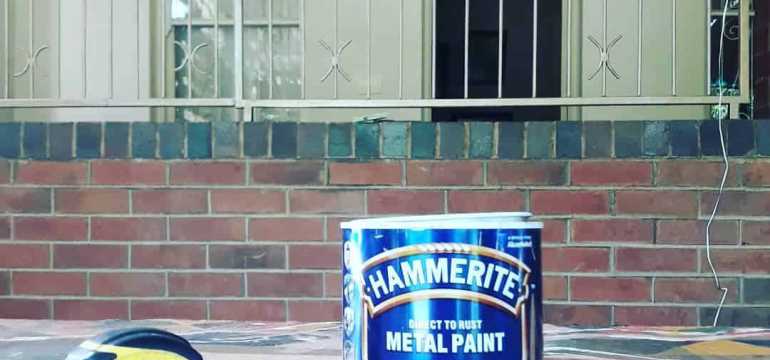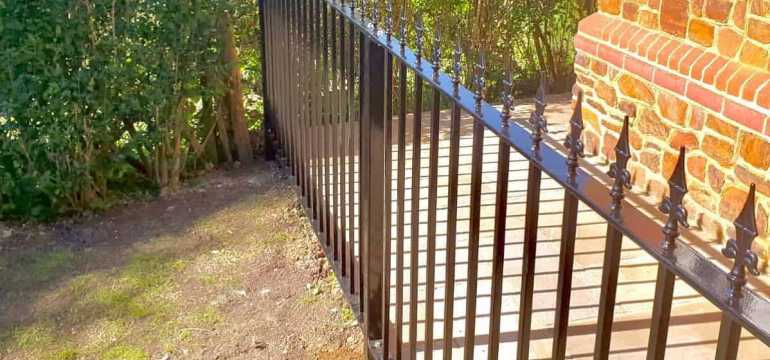Although powder coating produces a durable finish, it’s still can be scratched, dinged, or flawed. Scratches and other openings are vulnerable to oxidation. This oxidation can severely damage the surface, so when you find yourself in this situation, it’s best to repair and paint over the damage as soon as possible.
Can you paint over powder-coated surface, and if so, how do you do this?
The answer to the first question is yes, but you need to keep some considerations in mind before you start painting.
There are many kinds of materials that get powder coated, including fiberglass, plastic, aluminum, and metal. Metal is the most common material to get powder coated, so that’s what we’ll focus on here.
Common challenges when painting over a powder coat
 A couple of challenges you should consider include first the paint’s ability to bind itself to the surface. When you powder coat a surface, the texture is typically flat and smooth. The problem with this is that the paint doesn’t typically bind to this kind of surface very well. This can be quite frustrating if you’re in this situation.
A couple of challenges you should consider include first the paint’s ability to bind itself to the surface. When you powder coat a surface, the texture is typically flat and smooth. The problem with this is that the paint doesn’t typically bind to this kind of surface very well. This can be quite frustrating if you’re in this situation.
So, how do you overcome this? To get the paint to stick to the smooth, flat powder-coated surface, you’ll need to rough up the surface with some sandpaper or a sandpaper block. By doing this, the paint will stick much better and will ultimately look better too.
Make sure you sand the whole area, including the edges. This will create a powerful bond. When choosing your sandpaper, aim for a light grade. Once you’re finished sanding the surface, take a quality solvent cleaner, dampen a rag or towel with the solution, and wipe down the surface. This will remove any excess dust.
Another challenge you’ll face when painting over a powder-coated surface is matching the paint’s coat to that of the powder coat. The less they match, the worse your surface will look. Although this may seem like a big problem, there is somewhat of a solution. Try and choose a paint that has the same performance characteristics as the powdered surface you’re about to paint.
The best thing you can do is to talk with a coating expert and see which paint would be best for your needs. This will largely depend on the environment and the reason you’re painting over the powdered coat, for performance or for appearance.
Lastly, how you apply the paint over the powder coat will determine how well the paint sticks and how well it looks when the surface is completely dry. Some of the different methods include paint sprayers, brushes, rollers, airbrushes, and so on. Your method will largely depend on the kind of surface you’re painting over. The best plan of action is to consult with a professional painter to see what painting method works best for you.
Special considerations when painting over a powder coat
There are a couple of things you should consider when painting over a powder coat. One of the most important things is how well the powder coat stays intact. Before you start painting, inspect the powder coat. You want to look for areas that have less coating than the rest of the surface. If it’s uneven, you might want to remove all the coating and start from scratch. To do this, you will need to sandblast the coat off and start over.
Another thing that you’ll want to consider is how bad the substrate oxidation is. Substrates with a lot of rust or a high degree of rust will more than likely need to be sandblasted. This will remove the rust. A rust-free substrate is necessary before you start painting. Neglecting to remove the rust can cause your paint not to stick, and if it does stick, the appearance of the final coat will more than likely be low quality.
You can paint over powder-coated metal, but how do you do this?
 The first thing you’ll want to do is properly clean your surface. This is necessary to remove all the grease, dirt, grime, and other filth that may be on the surface. The best cleaner to use is trisodium phosphate. If you’re concerned about being environmentally friendly, you can also use a cleaner that’s more ecologically sound, but make sure the solution you use also serves as a degreaser too.
The first thing you’ll want to do is properly clean your surface. This is necessary to remove all the grease, dirt, grime, and other filth that may be on the surface. The best cleaner to use is trisodium phosphate. If you’re concerned about being environmentally friendly, you can also use a cleaner that’s more ecologically sound, but make sure the solution you use also serves as a degreaser too.
In addition to this, make sure you spray the solution through a power washer and use a 900 to 1000 psi setting. This will thoroughly clean the surface. If you do decide to handwash the powder-coated surface, use a soft-bristled brush. Once you’re done washing it, rinse the surface off with warm water and let the surface air dry.
As mentioned above, adhesion is important, and with a smooth, flat powder-coated surface, the paint can have a hard time sticking. As a result, you’ll need to use a light-grade sandpaper to scuff up the surface enough to get the paint to stick. If the paint still doesn’t stick, sand the surface a bit more. Once finished, remember to clean the surface with a quality solvent cleaner.
Once you have sanded the powder-coated surface you’re going to paint; you’ll also want to prime it. When you go to the home improvement store to pick up your primer, make sure you choose a primer that works well on metal. Before you begin to apply your primer, use the primer to test the adhesion. To do this, apply a small amount and then wait 20 to 30 minutes for the primer to dry.
Take a damp cloth and try and wipe off the primer. If the primer doesn’t wipe off, then you know you’re in the clear. However, if the primer does wipe off, then you’ll need to improve the adhesion of the surface. When you apply the primer to the bare areas, make sure you use a full coat.
The last step is to paint the powder-coated surface. This involves using the right kind of paint for your project. Even if you use the right primer, you’ll need the right paint to make sure it will adhere properly to the primer. The best paints you can use are epoxy-based paints. These paints will stick to just about any kind of surface, especially metal surfaces.
These paints are quite expensive and are typically only available in a limited amount of colors. Another paint that a lot of professionals use is enamel paint. Enamel paints are generally less expensive than epoxy-based paints and have a reputation for adhering to primers designed for metal surfaces really well.
Applying your primer and paint
There are several ways to apply your primers and paints, but which methods are the best choices for your needs. Some people like to use a brush, whereas others like to spray paint over powder coat surfaces with a spray can. So, which method is right for you?
Spraying your primer and your paint onto powder-coated metal surfaces will require a well-ventilated area. If you can’t work in a well-ventilated area, then you may want to use a paintbrush.
Another thing you’ll want to consider is the amount of time you have and the amount of effort you want to put into your project. Spraying your primer or your paint on with a can is faster and much easier than applying them with a brush. However, using a brush to prime and paint your powder-coated surface will generally result in a better-looking surface.
When you’re spraying your primer or your paint onto the surface, like mentioned before, do it in well-ventilated areas, and always hold the can 10 to 12 inches from the surface you’re spraying. Also, remember to move the can smoothly from left to right and avoid jerking the can. To decrease drips, sags, and runs, apply multiple thin layers instead of fewer thick ones.
If you decide to brush your primer or paint onto your powder-coated surface, make sure you use long, smooth, horizontal strokes, and always take your time. Never rush. Rushing leads to unnecessary mistakes. It also helps if you invest in a synthetic brush when applying your primer or your paint. These can be picked up at most home improvement stores. Lastly, it’s better to apply several thinner layers than fewer thicker ones. This will help eliminate drips, sags, and runs.
- Painting Over Powder Coat and What You Need to Know - February 1, 2022
- How to Get Rid of Humidity in a Basement Without a Dehumidifier - December 17, 2021
- How to Fix a Crack in Drywall That Keeps Coming Back - September 22, 2021

